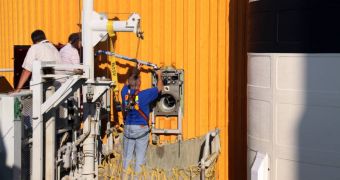According to a press release published recently on NASA's official website, the agency will perform a full external tank loading test tomorrow (July 1st), in order to accurately assess if the repairs made on the space shuttle Endeavor's external hydrogen tank were successful. The importance of these tests cannot be underlined enough. NASA was already forced to scrub the STS-127 mission twice, because of the same faulty hydrogen transport line, but now the agency's schedule is tighter than ever.
With the next launch window opening on July 11th, it's absolutely necessary that the spacecraft launches then. Any further delays, and the entire launch manifest that the American space agency has set up for this year may go down the drain, with shuttle Discovery's next mission already in danger of being postponed. After each launch, a number of modifications need to be made to the launch pads, therefore about a month is usually left as adjustment time between launches.
Additionally, the Kennedy Space Center, which is the Shuttle Program's home base, no longer benefits from the support of two launch pads. Only 39A remains, as 39B was officially handed over to Project Constellation, as soon as Atlantis returned from its Hubble servicing mission, and Endeavor's role as back-up in the STS-400 mission ended. Under these circumstances, it may become even harder to fit at least two or three shuttle launches this year at the KSC, alongside STS-127.
In the new tests, which are scheduled to begin at 7 am EDT (1300 GMT), Endeavor's external hydrogen fuel tank will be filled up just as it is moments prior to the launch itself. The goal is to see if the Ground Umbilical Carrier Plate, or GUCP, is repaired or not. This ensemble is, in fact, a line used for venting excess hydrogen away from the launch pad, when the craft launches. After it exists the external tank through a special valve (which was also changed), the hydrogen is led to a flame, a few hundred feet away from the launch pad, where it is burnt.

 14 DAY TRIAL //
14 DAY TRIAL //